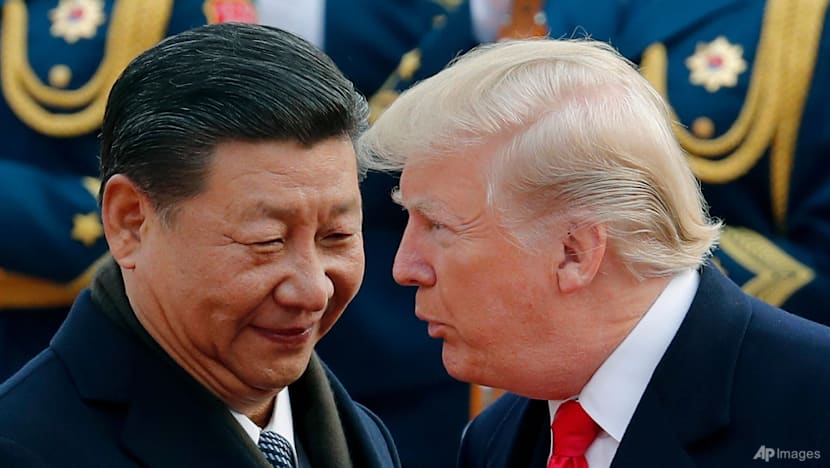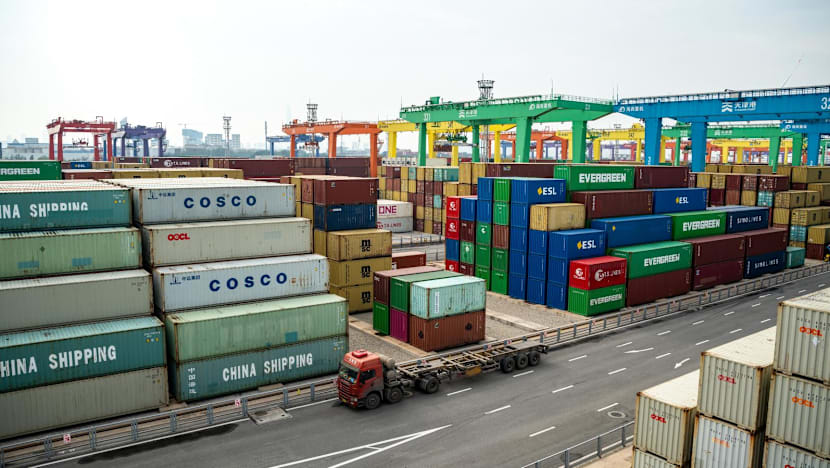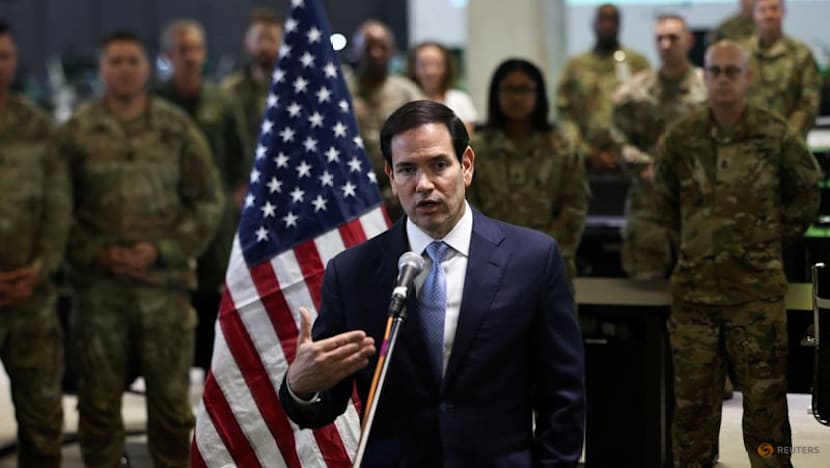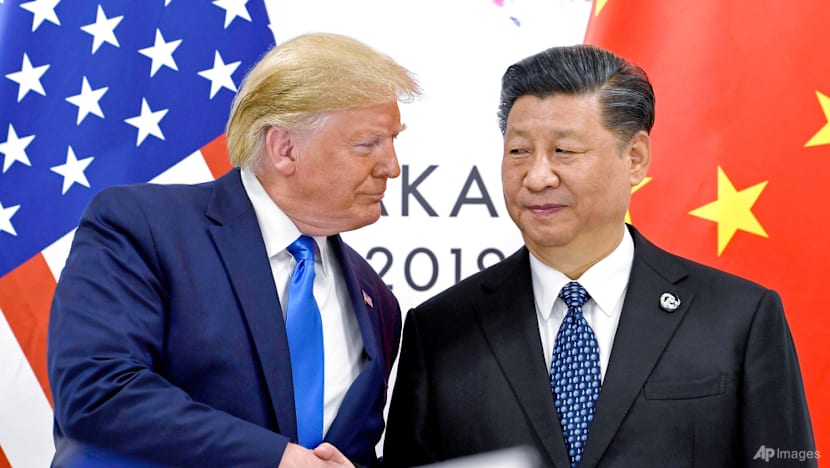analysis East Asia
When Trump meets Xi: What’s on the agenda and who might have the upper hand?
The high-stakes meeting will test how far both countries are willing to steady ties strained by trade disputes, tech rivalry and geopolitical competition, analysts told CNA.


This audio is generated by an AI tool.
BEIJING: When United States President Donald Trump and Chinese President Xi Jinping meet face-to-face on Thursday (Oct 30) at the Asia Pacific Economic Cooperation (APEC) summit in South Korea, the world will be watching how the two will chart the next phase of their relationship - marked by both rivalry and co-dependence.
The high-stakes meeting, which has been touted by Trump and US officials for days and was officially confirmed by China on Wednesday, will test how far Beijing and Washington are willing to steady ties strained by trade disputes, technological rivalry and geopolitical competition, analysts told CNA.
Notably, it will also be their first meeting in Trump’s second presidential stint, and comes amid simmering trade tensions that flared again this year.
Their last face-to-face encounter was back in November 2019 - at the G20 Summit in Osaka, Japan, where both sides sought to de-escalate a bruising tariff war that had rattled global markets.
Analysts say the agenda this week is broad with several key issues that each reflects a different facet of US-China competition - economic, strategic and political - following months of manoeuvring aimed at building leverage ahead of the summit.
“Both sides have incentives to maintain dialogue amid global economic uncertainty,” Jonathan Ping, an associate professor at Bond University in Gold Coast, Australia, told CNA.
“The US and China are focused on domestic outcomes and are looking for pragmatic opportunities to de-escalate the trade war.”
Officials from both sides have signalled that the meeting would be more focused on keeping channels open, rather than securing breakthrough deals.
The White House said both leaders would meet on the summit sidelines in South Korea, describing it as part of ongoing high-level engagement between the two countries.
Beijing, meanwhile, has adopted a more cautious tone. In comments on Oct 24, Chinese foreign ministry spokesperson Guo Jiakun said “China and the US were maintaining close communication regarding a possible meeting between the two heads of state” - and further details would be released in due course.
For Beijing, the focus will be on preserving calm and setting the tone for future engagement.
This summit is about “stability and strategic guidance”, said Sun Chenghao, a fellow at Tsinghua University’s Centre for International Security and Strategy.
But Washington’s priorities will be about pressing economic concerns - notably addressing the US trade deficit with China while securing greater market access for US firms, and seeking cooperation on issues such as fentanyl control and critical minerals.
“Leaders’ meetings play two roles,” added Sun.
“One is strategic leadership; the other is setting strategic expectations. Knowing a summit is coming makes both sides more willing to cool rhetoric and take constructive steps.”
Against this backdrop of cautious diplomacy and calibrated messaging, CNA looks at what issues are on the agenda - and how each side hopes to shape the outcome.
TRADE: AN “ONGOING GAME OF ECONOMIC CHESS”
Trade remains the central pillar, and flashpoint, of the Trump-Xi meeting, according to analysts.
Tensions between Washington and Beijing flared earlier this year after the Trump administration linked trade policy to national security.
In February, Trump declared a national emergency over synthetic opioids, including fentanyl, and authorised additional tariffs on Chinese goods - connected to what he called a “threat to US public health and security”.

The move marked a significant escalation in his strategy of using economic pressure to advance enforcement goals.
A month later in March, the US Trade Representative’s office expanded tariffs on a wide range of Chinese imports, citing unfair trade practices and industrial subsidies which it said distorted global markets.
Beijing retaliated in April with a 34 per cent tariff rate on US goods, accusing Washington of violating international rules.
China’s State Council Tariff Commission called the measure a “necessary countermeasure” to defend national interests, and tightened export controls on rare-earth materials critical to US industries.
For Washington, priorities include addressing structural imbalances in bilateral trade, securing access to rare earths and protecting key agricultural exports such as soybeans, which have fallen to historic lows because of high tariffs China has imposed on US imports.
Beijing, meanwhile, will be focused on limiting escalation and avoiding unilateral concessions.
Issues like rare earths, soybeans and fentanyl are all matters that China is willing to discuss, said Ren Xiao, a professor at Fudan University’s Institute of International Studies.
“But they must be discussed on the basis of mutual respect,” he added.
Observers said both sides enter the summit with distinct, and shifting, advantages on the trade front.
Some added that Washington holds stronger cards through its expanding web of trade alliances and diversification strategies, while others believe Beijing retains leverage through its dominance in critical resources and its capacity for long-term economic planning.
China “would probably want market access to the US and perhaps fewer technology restrictions”, said Chong Ja Ian, an associate political science professor at the National University of Singapore (NUS), adding that “a major breakthrough over fundamental issues” was unlikely.
Speaking on the sidelines of the Association of Southeast Asian Nations (ASEAN) Summit in Kuala Lumpur last weekend, US Treasury Secretary Scott Bessent said Washington and Beijing had agreed on a “very successful framework” for the upcoming Trump-Xi meeting, following talks with Chinese Vice Premier He Lifeng and Vice Commerce Minister Li Chenggang.
The framework covers areas such as tariffs, rare-earth export controls, agricultural trade and fentanyl cooperation, Bessent said.
Observers note that both sides have accelerated parallel trade and supply-chain initiatives ahead of the summit - Washington by expanding regional partnerships to reduce reliance on China and Beijing by deepening its own economic outreach in Asia.
The ASEAN Summit itself saw a flurry of activity. On Tuesday, China and ASEAN signed the upgraded ASEAN-China Free Trade Area (ACFTA 3.0), expanding cooperation into digital and green economies, supply-chain connectivity and market access in sectors such as agriculture and pharmaceuticals.
Days earlier, Trump signed a series of reciprocal trade agreements with Thailand, Malaysia, Cambodia and Vietnam aimed at addressing tariff and non-tariff barriers.
The deals maintained existing tariff levels - 19 per cent for most exports from Malaysia, Thailand and Cambodia, and 20 per cent for Vietnam - and included cooperation on diversifying critical minerals supply chains, part of Washington’s broader push to secure alternatives to Chinese exports.
Such moves are “akin to an ongoing game of economic chess”, said Ping from Bond University.
“The talks could yield modest outcomes such as reduced tariffs on selected goods, renewed tech cooperation or clearer supply-chain protocols. However, deep disagreements, especially around tech sovereignty and strategic industries, may limit breakthroughs.”
Others noted that Beijing appears to be managing what some call “Trade War 2.0” more deftly than during Trump’s first term. Having broadened its economic toolkit and developed targeted countermeasures, China has at times forced Washington to soften its stance - allowing Beijing to make incremental gains in trade and supply-chain talks.
Tsinghua University’s Sun also cautioned against viewing the balance of power as fixed.
“It’s dynamic - constantly changing,” he said. “When the US plays a new card, it might seem like Washington has the upper hand for a moment.”
“Then China responds, and the advantage swings back. It’s a process of move and counter-move, a back-and-forth where it’s hard to say one side consistently dominates.”
TIK-TOK: WHEN TRUST AND TECH COLLIDE
The tug-of-war between Beijing and Washington is also evident in the tech arena, where disputes over data, security and market access have become the next front in their rivalry.
At high stake is the battle for TikTok, which has become a proxy for the larger contest over tech dominance and digital trust between the two global powers.
For Washington, the popular youth video app embodies long-standing concerns about data security and potential state influence. For Beijing, it represents resistance to what it sees as the politicisation of trade and technology.
How the two sides frame TikTok at the APEC summit will offer a glimpse into how they can manage competition in the digital space - or if the tech rivalry is set to harden further, said Bond University’s Ping.

TikTok has remained a fixture in ongoing US-China negotiations, when Trump and Xi last discussed the app during a phone call that paved the way for a tentative deal to keep its US operations running under stricter oversight.
The Trump administration has made clear that any final approval would hinge on ByteDance’s compliance with US data-security rules, including storing user data domestically and establishing an independent board for its US arm.
Officials have also argued that Chinese ownership poses risks to American users’ data and could influence operations - concerns continued to be echoed by lawmakers in Congress.
Beijing, however, has insisted that any sale or restructuring must comply with Chinese laws on data exports and intellectual property, underscoring that TikTok’s algorithm is a protected national technology.
The issue is now inseparable from the broader trade agenda, said Sun of Tsinghua University.
“Export controls and technology restrictions have become part of the same conversation,” he said. “They are no longer just technical or economic matters - but symbols of how trust between both sides is being tested.”
While Washington wields leverage through its regulatory powers and control over market access, Beijing has strategic influence over how the deal is ultimately implemented.
The US can delay or shape ByteDance’s restructuring through legal and security reviews, but China’s approval remains essential for any transfer of technology or algorithmic assets - a key sticking point that keeps the balance finely poised.
Analysts said the TikTok standoff is less about commercial ownership than political signalling.
For Washington, pressing the issue reinforces its message of safeguarding national security, and for Beijing, standing firm on the algorithm asserts its defence of technological sovereignty.
Any potential moves would reflect how both powers approach the issue with longer-term strategic considerations, rather than treating it as an isolated dispute, Sun noted.
Incremental progress on such sensitive technology matters could help stabilise the broader economic relationship. But any misstep would risk reigniting tensions, Ping warned.
The outcome on TikTok, he added, will likely serve as a barometer for how both sides manage competition in the digital arena in the years ahead.
TAIWAN: THE NON-NEGOTIABLE REDLINE
Few issues cut more deeply into US-China relations than Taiwan - a self-governed island which Beijing views as a breakaway province that must eventually be reunified, by force if necessary - while Taipei, which has long enjoyed strong unofficial support from Washington, sees that backing as a crucial safeguard for its security and international standing, particularly amid China’s growing military and diplomatic pressure.
Its fate has become a barometer of power rivalry in Asia and it sits at the heart of the contest between Beijing’s drive for reunification and Washington’s commitment to supporting a democratic partner and preserving stability, and influence, across the region, said analysts.
Taiwan remains the political fault line in the relationship, and observers suggest both powers could restate their long-held positions at the APEC summit.
Speaking to reporters before his departure to Asia on Oct 25, Trump said he will raise the issue of Taiwan. “I will be talking about Taiwan (with Xi),” he said.
When asked by reporters on board Air Force One why he had previously said China would not make any move on Taiwan, Trump said it would be very dangerous for them to do so.
“I hope they won't. We'll have to see,” Trump said. “Maybe they will. Maybe they won't. I hope they won't. I think it would be very dangerous for them to do.”
Still, Sun said he does not expect Trump to prioritise Taiwan. “Trump himself doesn’t care that much about Taiwan but (members of his team) - people like Marco Rubio - still view it as a card to raise China’s cost of unification,” he said.
Speaking to journalists in Washington on Oct 25, US Secretary of State Rubio, said Taipei “should not be concerned” that its interests would be compromised in any potential trade understanding with Beijing.
He also said Washington had “no plans to trade away security commitments for economic concessions” and that Taiwan remained an important partner under the Trump administration’s Indo-Pacific strategy.

But such assurances are largely symbolic, according to analysts, with little sign of substantive change.
Sun said any comment from Trump such as “I don’t support Taiwan independence” would merely echo long-standing US policy. “It’s (encouraging) to Beijing’s stance on Taiwan, but wouldn’t change anything fundamental,” he added.
“Unless Washington were to say it supports peaceful unification - which would be far more meaningful - (though) statements alone carry little weight.”
And China views Taiwan as a matter of sovereignty, not negotiation, Sun added. “No amount of US pressure will change China’s determination. It’s not something that can be traded.”
The issue of Taiwan is where symbolism meets strategy stakes in US-China relations, experts say.
For Washington, the intent is to deter escalation while maintaining stability across the Taiwan Strait. For Beijing, proximity and sovereignty make the issue central to its core national interests and domestic politics.
Ren from Fudan University said China’s position remains unshakeable. “China’s policy toward the US is highly stable and consistent, and it enjoys strong support from the Chinese public,” he said. Questions touching on sovereignty, he added, “remain non-negotiable” for Beijing.
OTHER BARGAINING CHIPS
Beyond trade and security, observers suggest other topics could surface informally during the Trump-Xi meeting, among them, cooperation on fentanyl precursor controls and human rights concerns.
The US wants tangible cooperation from China on stemming the flow of fentanyl precursors, which US authorities have linked to overdose deaths across the country.
Trump has repeatedly tied trade tariffs and law enforcement to the issue, hinting that stronger Chinese action on fentanyl could ease economic pressure in other areas.
For Washington, progress on this front carries domestic political weight, as the opioid crisis remains a key talking point for the Trump administration.
In recent statements, China’s Ministry of Public Security said it had maintained “working-level cooperation” with US agencies on precursor control and information sharing, while cautioning against “politicising” the issue.
At the same time, Washington has continued to raise broader human rights concerns as part of its engagement with Beijing, underscoring how non-trade issues remain intertwined with the wider relationship.
In late September, Trump publicly urged Beijing to release Hong Kong media tycoon Jimmy Lai, who remains in custody, pending trial, under the city’s national security law on charges of colluding with foreign forces and conspiring to publish seditious materials.
Chinese officials have pushed back against US pressure on domestic legal cases such as Lai’s, framing such comments as interference in China’s internal affairs.
While such topics are unlikely to feature formally on the summit agenda, analysts said they believe these could shape the tone of engagement.
Both sides are likely to pursue selective cooperation to stabilise ties, said Bond University’s Ping.
Others add that in these peripheral areas, symbolism often matters as much as substance - and that cooperative gestures, such as renewed counternarcotics dialogue, could help maintain a veneer of stability even as core differences remain unresolved.
GLOBAL MARKETS BRACING FOR IMPACT
Financial markets will be watching closely for signals from the Trump-Xi meeting - and for what they could mean for China and the US.
Early market reaction was mixed: oil prices rose on Oct 27, on hopes that easing US-China frictions could ease global growth risks.
Some stock-market indexes, including in China, picked up modest gains, while US futures and dollar markets remained cautious, which traders say reflected uncertainty over how much a broad framework without detailed terms could actually deliver.
A Reuters report this week noted that traders tend to react more sharply to disappointment than to modest progress, recalling how optimism and market behaviour during the 2019 and 2020 rounds of US-China negotiations, were often followed by volatility once talks stalled or details had failed to materialise.

Analysts say investors are taking a similar approach this time, pricing in modest optimism but bracing for swings if rhetoric hardens or if the summit ends without a clear roadmap on tariffs or supply-chain cooperation.
Chong from NUS said the meeting might yield arrangements to “reduce volatility and uncertainty surrounding tariffs, technology and supply chains” - but stressed that neither side is bound by them.
“Even if there is some mutual understanding at the summit, it is very easy and perhaps cheap for both sides to just walk away or change their minds later,” Chong said.
Others see value in the meeting’s strategic signalling, even if outcomes remain modest.
Tsinghua University’s Sun said a leaders’ summit could help “provide direction and set expectations”.
If the White House proceeds with plans for Trump to visit China before the Lunar New Year, followed by a reciprocal visit by Xi to the US later in the year, both sides “could work pragmatically to create the right conditions”, Sun said. “That’s how summits can stabilise relations.”
Others note that such exchanges underscore a key truth in US-China diplomacy: that symbolism and signalling matter as much as concrete outcomes.
Ping of Bond University noted that the Xi-Trump meeting’s purpose is as much about managing perceptions as it is about producing results.
“Both will use it to reinforce their geopolitical standing in the region,” Ping said.
But even so, rhetoric remains a risk. Ren of Fudan University cautioned that the US “must stop wielding its big-stick approach”. “China doesn’t buy into that,” he said - a reminder that sharp words or gestures could quickly undo the goodwill the summit aims to build.
For now, even limited progress, or simply the optics of civility, could help steady markets and give both sides space to manage a more structured form of competition, said Sun.
“It’s not about who wins outright. It’s about keeping the game under control.”



















